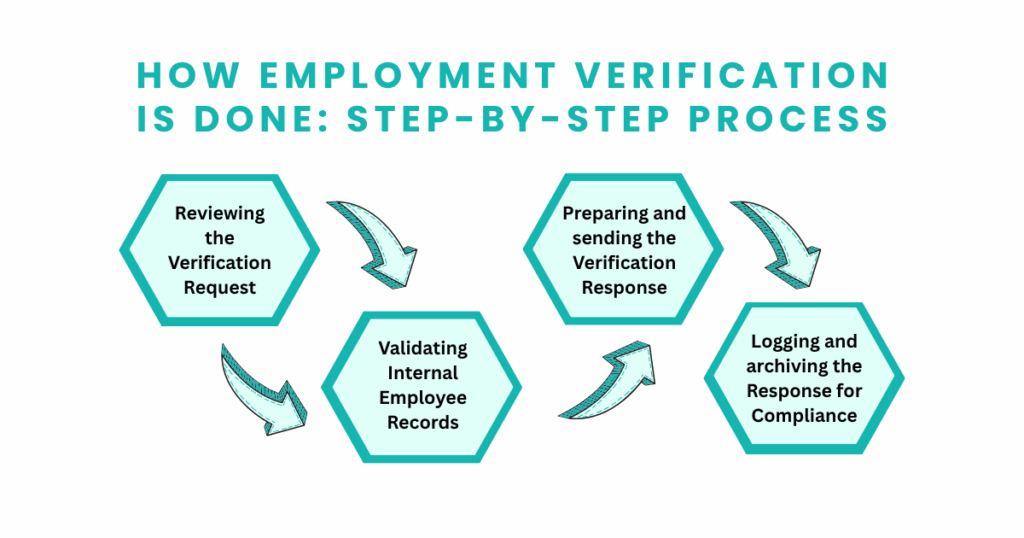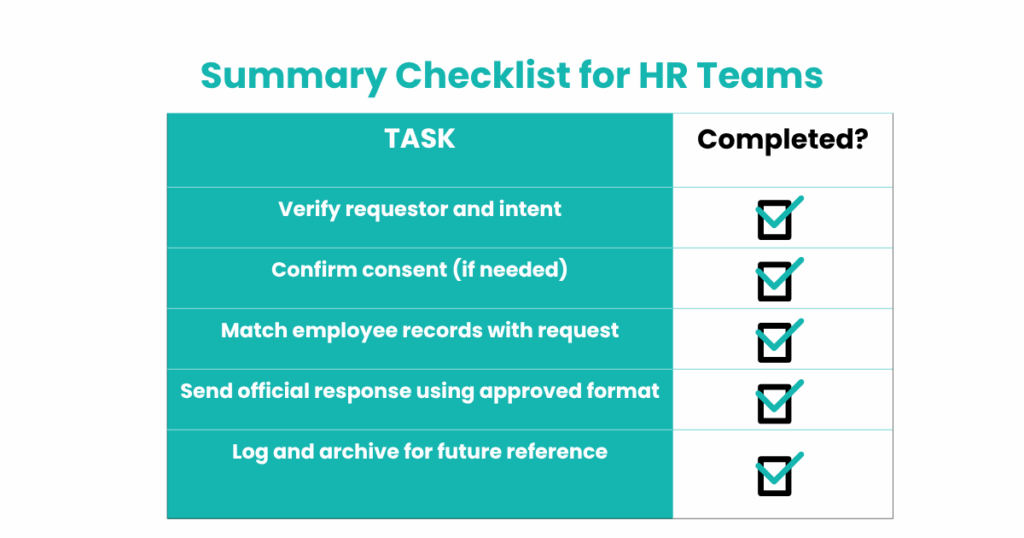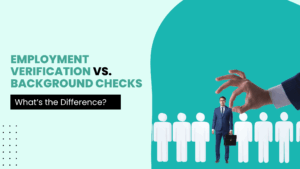Table of Contents
A verification request just landed in your inbox. It’s from a mortgage company asking if your former employee really worked here. You open the email and pause. What exactly can you say? And what should you hold back?
Employment verification is a routine part of HR and background screening, but it comes with real consequences. One incorrect response or one piece of missing consent, can affect someone’s job offer, housing, or immigration application. For HR teams, it’s also a matter of legal compliance and consistency.
In this guide, we break down how employment verification actually works. You’ll learn:
- What employers can legally share (and when consent is required)
- How the employment verification process works step by step
- The employee’s role and rights
- When to use automated verification tools vs. handling it manually
- How to avoid common mistakes and legal risks during HR employment checks
If you’re handling verifications at work or waiting for one to go through, this breakdown will help you do it with clarity and confidence.
What Employment Verification Actually Involves
Employment verification is the process of confirming an individual’s past or current work history. It typically includes verifying key details such as job title, duration of employment, and employment status.
In some cases, it may also involve additional checks, such as salary confirmation or reasons for leaving, depending on the requestor and applicable company policy.
This process is essential for organizations making hiring decisions, financial institutions processing loans, or government bodies evaluating eligibility for services. It ensures that the information provided by an individual is accurate and complete.
For employers, employment verification must comply with internal policies and legal guidelines. For employees, it is a reflection of their professional record and must be handled with transparency and care.
Who Usually Asks for Verification and Why?
| Requestor | Purpose |
| Banks or lenders | To confirm income and job stability for mortgage or loan approvals |
| Recruiters / employers | As part of pre-employment background screening |
| Immigration offices | For visa applications, sponsorship, or permanent residency |
| Landlords / leasing agents | To verify income before leasing property |
| Government agencies | For audits, benefits applications, or clearance |
Example:
A background screening agency working on behalf of a new employer may request a full employment verification including salary. HR should verify whether the employee has signed a release form — otherwise, they should limit the response to job title and dates.
How Employment Verification is Done: Step-by-Step Process
Whether you’re responding to a background check, loan inquiry, or visa application, employment verification needs to be handled clearly, consistently, and within the legal scope.
Here’s the standard 4-step process most HR teams follow:

- Reviewing the verification request
- Validating internal employee records
- Preparing and sending the verification response
- Logging and archiving the response for compliance
Below is a breakdown of each step, including what HR should do and what employees should know.
1. Reviewing the Verification Request
Start by carefully reviewing the request. Who is asking? What are they asking for? Some requests only ask for basic job details. Others go deeper, like salary or reasons for leaving need employee consent.
For HR:
- Check if the request came from a valid source (e.g., employer, lender, government agency).
- Look for a signed consent form if sensitive data is requested.
- Ask for the request in writing if it came over the phone.
For Employees:
- Ask who will contact your employer and what they’ll ask.
- Always review forms you’re asked to sign, they may allow full access to your job history.
2. Validating Internal Records
Once the request is confirmed, make sure your records are up to date. Mismatched information can create confusion or delays for the person being verified. HR teams must
- Retrieve the employee’s official records from your HR system.
- Cross-check full legal name, dates of employment (start and end), official job title and current employment status (if applicable)
Make sure everything matches what’s stored in your system of record. Discrepancies can cause delays or issues for the employee.
However, if you are a candidate and have recently changed roles or left the company, check with HR to ensure your record reflects the most up-to-date information.
3. Preparing and Sending the Verification Response
Now it’s time to respond to the request. Always use a company-approved letter template or fill out the requester’s form carefully. Only include what’s allowed based on the type of request and whether you have consent.
For HR:
- Use a company-approved employment verification letter or complete the request form.
- Only include the information you’re authorized to share.
- Send the verification via official company email or on company letterhead.
Employees can request a copy of the letter or form submitted. If anything seems incorrect or incomplete, notify HR immediately to avoid complications.
4. Logging and Archiving the Response
After sending the verification, keep a record of the request and your response. This protects the company in case there are questions later.
Document name of the requesting party, information shared, who handled the response, and date of the request. This creates an internal audit trail and protects your company in case of disputes.
It’s good practice for employees to maintain their own records, including job offer letters, pay slips, and any verification letters shared during career.
Additional Image

Employment Verification: Manual Process vs. Automation
Not every company handles employment verification the same way. Some respond to every request by email. Others use tools that handle it automatically.
How you handle verification depends on the size of your company, how often you get requests, and how much time your HR team has.
Here’s a look at the two common methods: manual and automated.
Manual Employment Verification Process
In a manual process, HR teams receive verification requests by email or form. They search internal records, prepare a response, and send it back manually. This may work well for smaller teams or when request volume is low.
However, as the number of requests increases, manual methods often lead to delays, inconsistent responses, and difficulties in tracking what was shared and when. Without a proper system in place, it becomes harder to manage consent, maintain records, or ensure every request is handled according to company policy.
Automated Verification Systems
Automated systems help HR teams handle verification requests in a more consistent and scalable way. These platforms store employment data securely, apply access rules, and reduce manual effort by standardizing responses.
When both the requesting company and the responding company use the same platform, and employee records are already verified, the process becomes significantly faster and more accurate.
Automation also ensures better tracking, easier consent management, and a clear audit trail for compliance.
Platforms like WorkSure help organizations manage verification in a more organized way. It allows companies to send and respond to verification requests with structured forms, track what information was shared, and maintain secure records.
Legal and Compliance Risks in Employment Verification
Responding to employment verification requests involves more than just sending job details. Each request carries legal and privacy risks. A small error can lead to major problems, especially if sensitive information is shared without proper checks.
Below are four common risk areas HR teams should actively manage.
Sharing Sensitive Information Without Consent
Some employment details can be shared without consent, like job title and dates of employment. Others, like salary, reason for leaving, or disciplinary records, are considered sensitive.
Sharing these without employee consent may lead to formal complaints or legal action. Moreover, it damages trust between the company and its current or former employees.
Therefore, always confirm that you have signed consent before including any personal or confidential data in a verification response.
Inconsistent Practices Within the HR Team
When different team members respond in different ways, it creates confusion. One person may send salary details, while another refuses to share the same for another employee. This inconsistency can create legal exposure, especially if incorrect or conflicting information is provided.
The solution is simple: define one clear process. Train everyone who handles verifications, and ensure:
- A single, approved template is used
- Consent is always verified the same way
- Every response is logged and tracked
Overlooking Regional Legal Requirements
Employment laws vary by country. In some regions, basic data can be shared without restrictions. In others, even disclosing an employee’s job title may require consent.
For instance, in Pakistan, sharing identifiers like CNIC or salary information requires extra care. Employers must ensure that all responses meet local labor and data privacy laws.
Therefore, to stay compliant, review local laws annually and update your internal process to reflect changes.
Sample Employment Verification Letter and Process Tools
A clear, well-written employment verification letter helps avoid confusion and speeds up decision-making for banks, employers, government offices, or visa agents. Most requests ask for a basic format, confirming the employee’s role, duration, and status.
Below is a standard sample you can use or adapt for your company.
Standard Employment Verification Letter Format
[Company Letterhead or Logo]
Date: [Insert Date]
To Whom It May Concern,
This letter is to confirm that [Employee Full Name] was employed at [Company Name] from [Start Date] to [End Date].
Their official job title during this time was [Job Title].
If you need further information, please contact us at [HR Contact Email or Phone Number].
Sincerely,
[Authorized HR Representative]
[Name & Title]
[Company Name]
[Company Address]
[Email / Phone]
What Should Be Included in a Basic Verification Letter
A basic employment verification letter must include the following details:
- Full employee name
- Official job title or position
- Start and end dates (or confirm if currently employed)
- HR or authorized person’s contact details
- Company letterhead or email from official domain
HR teams must keep a template stored centrally so it can be reused. Assign one point of contact (usually HR) to handle all verification letters.
Final Thoughts
Employment verification may look simple, but it requires care, accuracy, and a clear understanding of legal responsibilities. Whether you’re confirming job titles or responding to formal requests, it’s important to follow a proper process. This protects both your organization and the employee.
Manual verification processes can work for small teams, but as the number of requests increases, it becomes harder to manage without delays or mistakes. Keeping records, tracking consent, and using consistent responses become more important over time.
WorkSure helps companies manage employment verification in an organized and reliable way. It allows you to send or receive requests through secure forms and keeps a record of every interaction.
Related Articles
What Information Can be Released for Employment Verification?
What is Employment Verification and Why Does it Matter?
Frequently Asked Questions (FAQs)
How long does employment verification take?
It depends on the process. Manual verification usually takes 2 to 5 business days, depending on HR workload and the completeness of the request.
However, if the company uses a structured platform and records are pre-uploaded, responses may be processed within hours.
Can an employer refuse to verify past employment?
Yes, but it’s uncommon. Employers are not legally required to respond in all cases, though many do as a professional courtesy. If they do respond, they must follow internal policy and data protection rules.
Is employee consent always required for verification?
Not always. Basic information like name, job title, and employment dates can often be shared without consent. However, details like salary, reasons for leaving, or conduct history should only be shared with the employee’s written authorization.
What if incorrect information is shared during verification?
If incorrect details are shared, such as wrong job title or incorrect dates, the employee should contact the HR department immediately and request a corrected letter.
Is there a standard format for verification letters?
While there is no legal standard, most letters follow a simple structure:
- Employee name
- Job title
- Start and end dates
- Company contact information
Using a consistent format helps maintain professionalism and avoids confusion for third parties.





